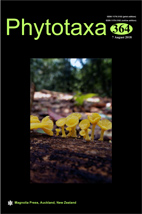Abstract
Prosopanche panguanensis, from the Peruvian lowland rain forest, is proposed as a new species. The species is similar to Prosopanche costaricensis but differs with solitary flowers (vs. flowers in fascicles), a perigonial tube prolonged above the insertion point of the synandrium (vs. perigonial tube not prolonged), and staminodes cucullate and sessile (vs. bilobed in the apex). A description, illustrations, pictures of live specimens, and information about its habitat and distribution are given. An account on Prosopanche specimens recorded from Peru and their identity is also provided.
References
<p class="Reference">APG IV. (2016) An update of the Angiosperm Phylogeny Group classification for the orders and families of flowering plants: APG IV. <em>Botanical Journal of the Linnean Society</em> 181: 1–20.</p><p class="Reference"> https://doi.org/10.1111/boj.12385</p><p class="Reference">Agardh, C.A. (1821) <em>Aphorismi botanici </em>7. Berling, Lund, pp. 87–102.</p><p class="Reference">Baillon, H. (1886) <em>Histoire des plantes </em>9 (1). Hachette & Cie., Paris, pp. 1–80.</p><p class="Reference">Barkman, T.J., McNeal, J.R., Lim, S-H., Coat, G., Croom, H.B., Young, N.D. & dePamphilis, C.W. (2007) Mitochondrial DNA suggests at least 11 origins of parasitism in angiosperms and reveals genomic chimerism in parasitic plants. <em>BMC Evolutionary Biology</em> 7: 248.</p><p class="Reference"> https://doi.org/10.1186/1471-2148-7-248</p><p class="Reference">Bolin, J.F., Lupton, D. & Musselman, L.J. (2018) <em>Hydnora arabica </em>(Aristolochiaceae), a new species from the Arabian Peninsula and a key to <em>Hydnora</em>. <em>Phytotaxa </em>338 (1): 99–108.</p><p class="Reference"> https://doi.org/10.11646/phytotaxa.338.1.8</p><p class="Reference">Brown, R. (1845) Description of the female flower and fruit of <em>Rafflesia arnoldi </em>with remarks on its affinities; and an illustration of the structure of <em>Hydnora africana</em>. <em>Transactions of the Linnean Society of London </em>19: 221–247.</p><p class="Reference"> https://doi.org/10.1111/j.1096-3642.1842.tb00365.x</p><p class="Reference">Bruch, C. (1923) Coleópteros fertilizadores de <em>Prosopanche</em> <em>burmeisteri</em> De Bary. <em>Physis</em> 7: 82–88.</p><p class="Reference">Cocucci, A.E. (1965) Estudios en el género <em>Prosopanche </em>(Hydnoraceae), revisión taxonómica<em>. Kurtziana </em>2: 53–74.</p><p class="Reference">Cocucci, A.E. & Cocucci, A.A. (1996) <em>Prosopanche </em>(Hydnoraceae): somatic and reproductive structures, biology, systematics, phylogeny and potentialities as a parasitic weed. <em>In</em>: Moreno, M., Cubero, J., Berner, D., Joel, D., Musselman, L. & Parker, C. (Eds.) <em>Advances in parasitic plant research</em>: <em>Sixth international parasitic weed symposium</em>. Junta de Andalucia, Dirección General de Investigación Agraria, Córdoba, pp. 179–193.</p><p class="Reference">De Bary, H.A. (1868) <em>Prosopanche burmeisteri</em>, eine neue Hydnoree aus Süd-Amerika. <em>Abhandlungen der Naturforschenden Gesellschaft zu Halle </em>10: 241–269.</p><p class="Reference">De Jussieu, A.L. (1789) <em>Genera plantarum secundum ordines naturales disposita</em>. Herissant, Paris.</p><p class="Reference">Gómez, P.L.D. & Gómez-Laurito, J. (1981) A new species of <em>Prosopanche </em>(Hydnoraceae) from Costa Rica. <em>Phytologia </em>49: 53–55.</p><p class="Reference">Harms, H.A.T. (1935) Hydnoraceae. <em>In</em>: Engler, A. & Harms, H.A.T. (Eds.) <em>Die Natürlichen Pflanzenfamilien, ed. 2</em>. 16b. Verlag von Wilhelm Engelmann, Leipzig, pp. 282–295.</p><p class="Reference">IUCN (2017) <em>Guidelines for using the IUCN Red List categories and criteria. </em>Version 11.<em> </em>Prepared by the Standards and Petitions Subcommittee in February 2014. Available from: http://www.iucnredlist.org/documents/RedListGuidelines.pdf (accessed 20 November 2017)</p><p class="Reference">JBM-Perú (2009) <em>Hydnoraceae C. Agardh. una familia nueva para la flora peruana</em>. Available from: <a href="http://www.jbmperu.org/curso/Hydnoraceae.pdf">http://www.jbmperu.org/curso/Hydnoraceae.pdf</a> (accessed 15 June 2016)</p><p class="Reference">Machado, R.F. & Queiroz, L.P. (2012) A new species of <em>Prosopanche </em>(Hydnoraceae) from northeastern Brazil. <em>Phytotaxa</em> 75: 58–64.</p><p class="Reference"> https://doi.org/10.11646/phytotaxa.75.1.5</p><p class="Reference">Massoni, J., Forest, F. & Sauquet, H. (2014) Increased sampling of both genes and taxa improves resolution of phylogenetic relationships within Magnoliidae, a large and early-diverging clade of angiosperms. <em>Molecular Phylogenetics and Evolution</em> 70: 84–93.</p><p class="Reference"> https://doi.org/10.1016/j.ympev.2013.09.010</p><p class="Reference">Meijer, W. (1993) Hydnoraceae. <em>In</em>: Kubitzki, K., Rohwer, J.G. & Bittrich, V. (Eds.) <em>The families and genera of vascular plants, Vol. II: Flowering Plants: Dicotyledons (Magnoliid, Hamamelid and Caryophyliid Families)</em>. Springer, Berlin, pp. 341–343.</p><p class="Reference"> https://doi.org/10.1007/978-3-662-02899-5_41</p><p class="Reference">Musselman, L.J. & Visser, J.H. (1986) The strangest plant in the world! <em>Veld Flora</em> 71: 109–111.</p><p class="Reference">Musselman, L.J. & Visser, J.H. (1989) Taxonomy and natural history of <em>Hydnora</em>. <em>Aliso</em> 12: 317–326.</p><p class="Reference"> https://doi.org/10.5642/aliso.19891202.09</p><p class="Reference">Naumann, J., Salomo, K., Der, J.P., Wafula, E.K., Bolin, J.F., Maass, E., Frenzke, L., Samain, M.S., Neinhuis, C., dePamphilis, C.W. & Wanke, S. (2013) Single-copy nuclear genes place haustorial Hydnoraceae within Piperales and reveal a Cretaceous origin of multiple parasitic angiosperm lineages. <em>PLoS ONE</em> 8: e79204.</p><p class="Reference"> https://doi.org/10.1371/journal.pone.0079204</p><p class="Reference">Nickrent, D.L., Blarer, A., Qiu, Y., Soltis, D.E., Soltis, P.S. & Zanis, M. (2002) Molecular data place Hydnoraceae with Aristolochiaceae. <em>American Journal of Botany </em>89: 1809–1817.</p><p class="Reference"> https://doi.org/10.3732/ajb.89.11.1809</p><p class="Reference">Shorthouse, D.P. (2010) SimpleMappr, an online tool to produce publication-quality point maps. Available from: <a href="http://www.simplemappr.net/">http://www.simplemappr.net</a> (accessed 20 January 2018)</p><p class="Reference">Spegazzini, C.L. (1898) Une nouvelle espèce de <em>Prosopanche</em>. <em>Comunicaciones del Museo Nacional de Buenos Aires </em>1: 19–22.</p><p class="Reference">Thunberg, C.P. (1775) Beskrifning paa en ganska besynnerlig och obekant svamp, <em>Hydnora africana</em>. <em>Kongalia Vetenskaps Akademiens Handlingar </em>36: 69–75.</p><p class="Reference">Ulloa Ulloa, C., Acevedo-Rodríguez, P., Beck, S., Belgrano, M.J., Bernal, R., Berry, P.E., Brako, L., Celis, M., Davidse, G., Forzza, R.C., Gradstein, S.R., Hokche, O., León, B., León-Yánez, S., Magill, R.E., Neill, D.A., Nee, M., Raven, P.H., Stimmel, H., Strong, M.T., Villaseñor, J.L., Zarucchi, J.L., Zuloaga, F.O. & Jørgensen, P.M. (2017) An integrated assessment of the vascular plant species of the Americas. <em>Science</em> 358: 1614–1617.</p><p class="Reference"> https://doi.org/10.1126/science.aao0398</p><p class="Reference">Valenzuela, L., Vásquez, R., Rojas, R., Villalba, M.I., Phillips, O., López, G., Chama, V., Monteagudo, A., Bellota, D., Huillca, Y. & Pallqui, N.C. (2015) Línea base para el monitoreo de la vegetación en la Reserva Comunal El Sira (RCS). <em>Arnaldoa</em> 22: 243–268.</p><p class="Reference">Vaccaneo, R. (1932) Una nuova <em>Hydnora</em> della Somalia Italiana. <em>Nuovo Giornale Botanico</em> 39: 304–308.</p><p class="Reference"> https://doi.org/10.1080/11263503209440420</p><p>Vasquez, R. & Rojas, R.D.P. (2016) <em>Clave para identificar grupos de familias de Gymnospermae y Angiospermae del Perú. Jardín Botánico de Missouri</em>. Available from: http://www.jbmperu.org/curso/Clave_Identificacion_Plantas.pdf (accessed 20 November 2017)</p>

